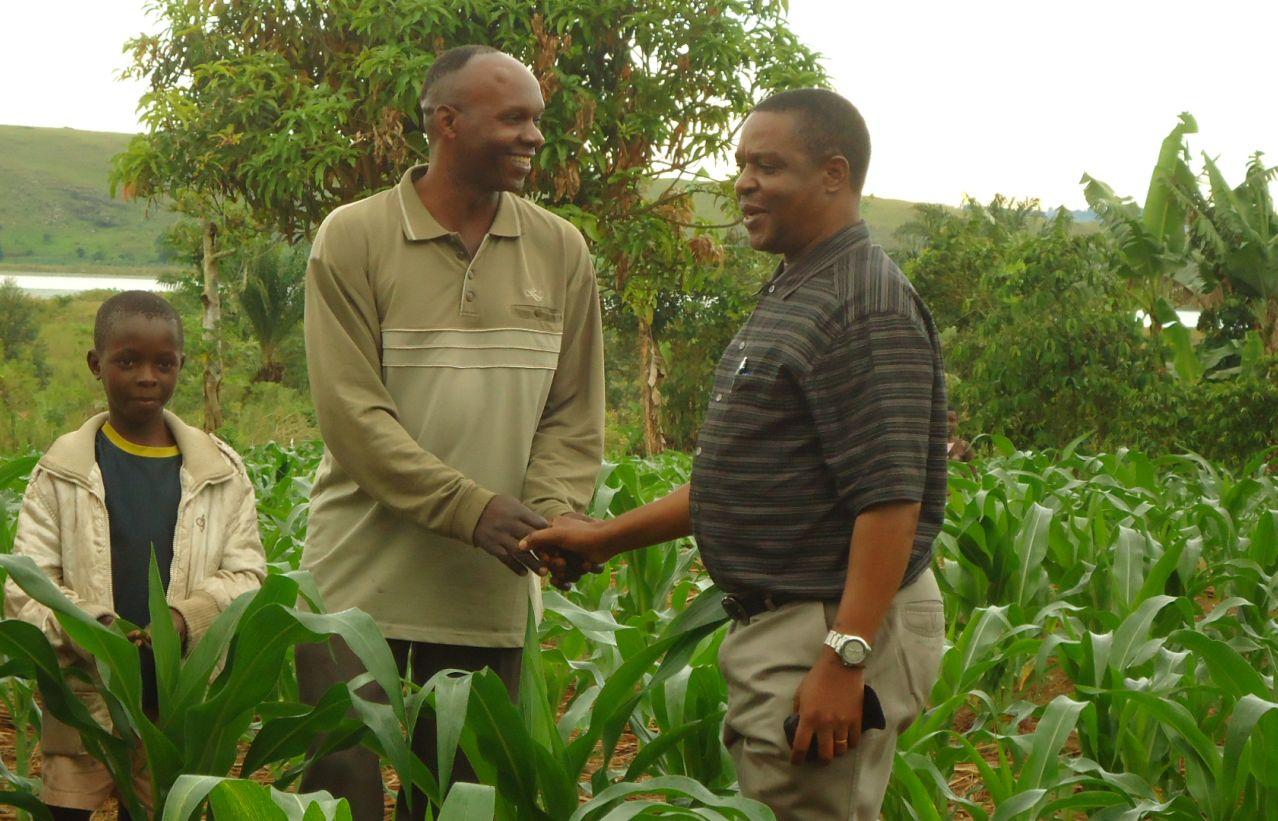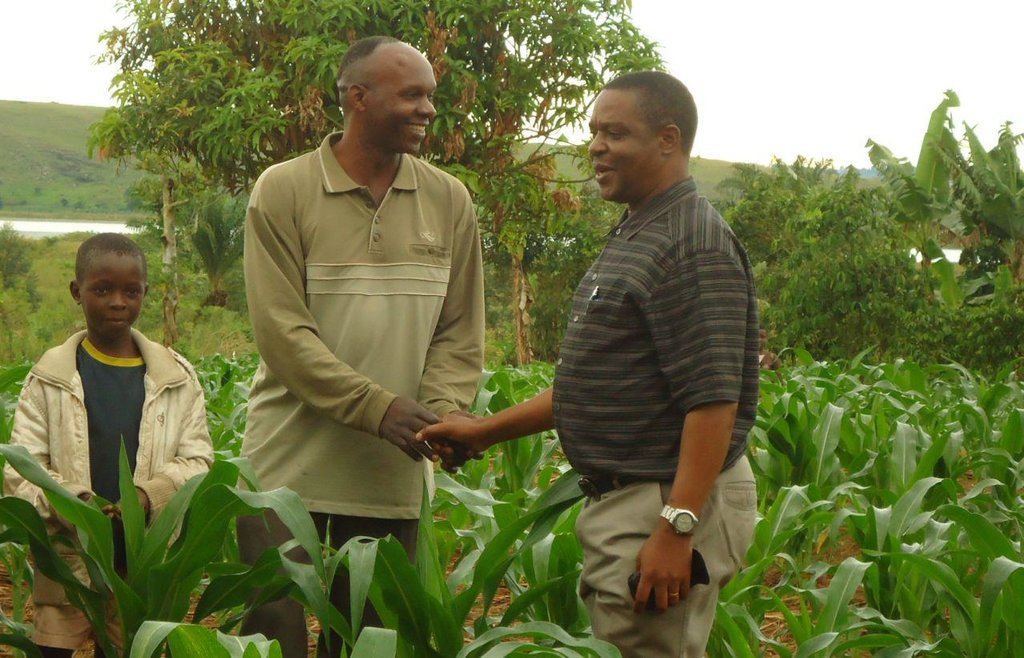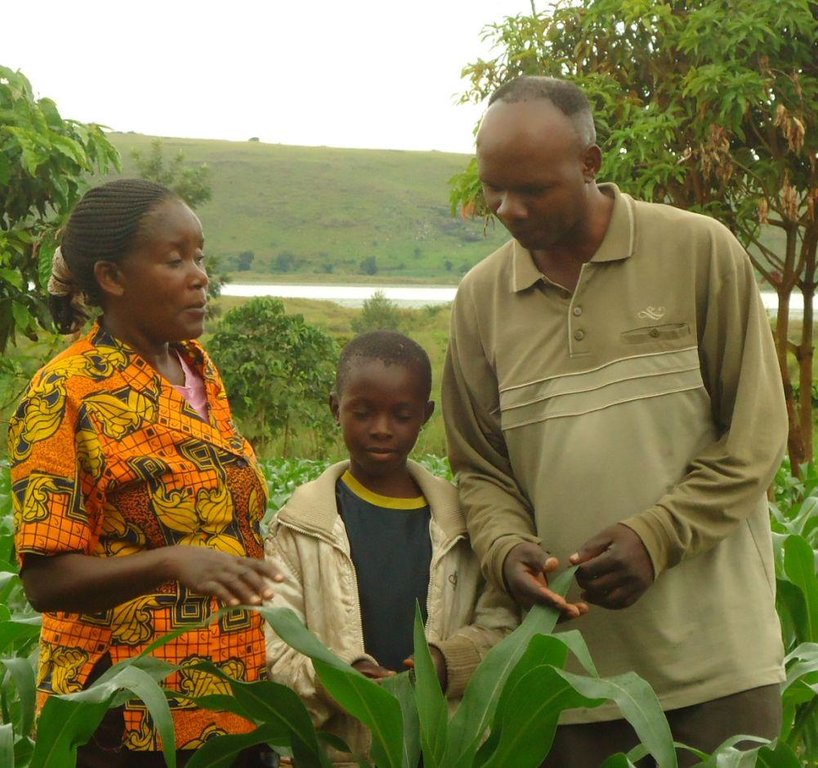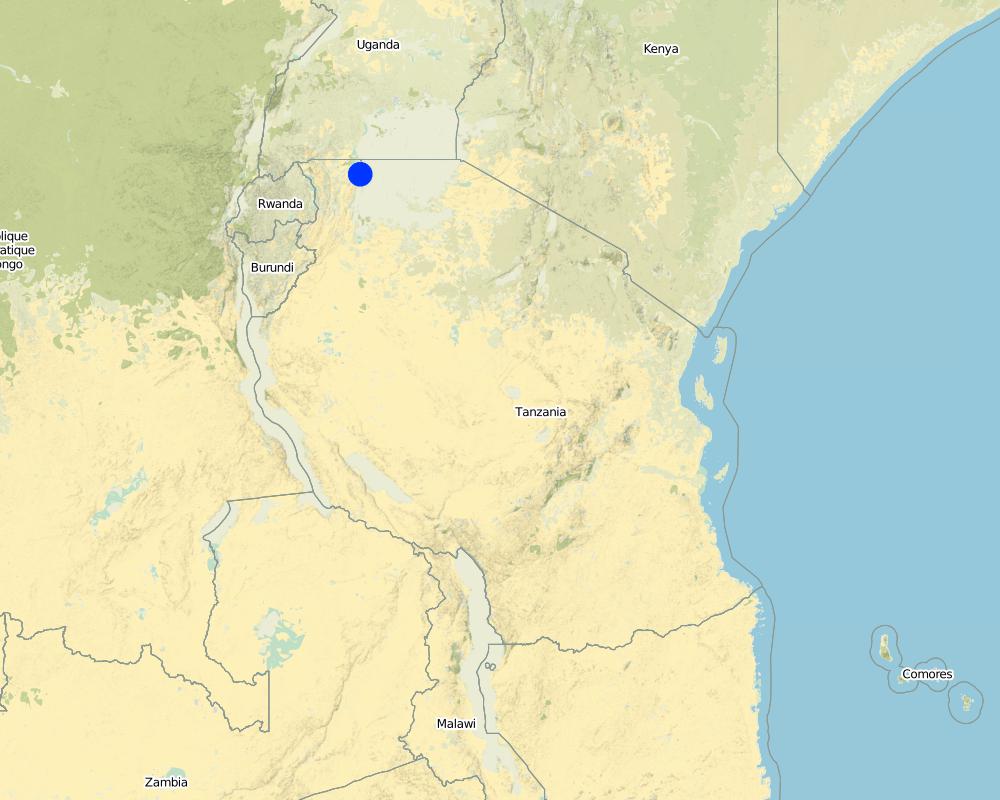Grass mulch combined with cow dung, Triple Supper Phosphate and Calcium Ammonium Nitrate in maize production. [坦桑尼亚联合共和国]
- 创建:
- 更新:
- 编制者: Godfrey Baraba
- 编辑者: –
- 审查者: Ursula Gaemperli, Fabian Ottiger, Alexandra Gavilano
Matandazo ya nyasi katika kilimo cha mahindi yaliyolishwa mbloea.
technologies_1199 - 坦桑尼亚联合共和国
查看章节
全部展开 全部收起1. 一般信息
1.2 参与该技术评估和文件编制的资源人员和机构的联系方式
SLM专业人员:
Nkuba Julitha
Bukoba District Council
坦桑尼亚联合共和国
SLM专业人员:
有助于对技术进行记录/评估的机构名称(如相关)
Missenyi District Council (Missenyi District Council) - 坦桑尼亚联合共和国有助于对技术进行记录/评估的机构名称(如相关)
Bukoba district council (Bukoba district council) - 坦桑尼亚联合共和国1.3 关于使用通过WOCAT记录的数据的条件
编制者和关键资源人员接受有关使用通过WOCAT记录数据的条件。:
是
1.4 所述技术的可持续性声明
这里所描述的技术在土地退化方面是否存在问题,导致无法被认为是一种可持续的土地管理技术?:
否
2. SLM技术的说明
2.1 技术简介
技术定义:
Is the spread of dry Hyperrhamia rufa across the slope combined with manures, Calcium Ammonia Nitrate and Triple Supper Phosphate in maize production.
2.2 技术的详细说明
说明:
The spread of dry Hyperrhamia rufa 15cm thickness across the slope combined with manures, TSP and CAN in maize production technology is applied on annual cropland for reduced declining soil fertility, reduced soil erosion and improved soil moisture content in the sustainable land agro-ecosystem management. The activities to implement the technology includes to slush bushes and cut grasses using sickles , to cultivate the land using hand hoes, to measure spacing demarcate and dig holes using hand hoes, to mix manure, soils and TSP in a 5cm depth hole using hands, to spread grass mulch using hands, to plant maize seeds using hand hoes, to apply CAN at week four after planting using hands, to weed the whole field using hands, to apply a mixture of ashes and pepper on the tip, closed tip leaf to control maize stock-bores and to harvest and trush using hands
This technology is applied on annual cropland using agronomic measures in the sub humid climatic zone. The slope category of that land is gentle, characterized of loam sandy soil textures with medium soil depth.
The technology is applied by Individual / household, Small scale land users, common / average land users, men and women. The Land ownership is individual, not titled and Land use rights is individual as well. Water use rights is open access (unorganized).
The relative level of wealth categorized as, rich, which represents 20% of the land users and own 32% of the total area. Average, which represents 64% of the land users and own 64% of the total area. Poor, which represents 20% of the land users and own 4% of the total area.
The technology was introduced in 2012 by TAMP -Kagera using FFS in the community integrated catchment approach.
To implement the technology it was calculated to be US$ 57.059 for establishment and US$ 1,923.36 maintenance costs.
Purpose of the Technology: The major purpose of the technology is to prevent loss of top soil, to improve soil fertility decline and reduced organic matter content on the annual cropland with a sustainable land management to improve community livelihood.
Establishment / maintenance activities and inputs: This technology has no establishment activities as a common phenomena for all Agronomic measures. The maintenance activities of the technology includes; To slush bushes and cut grasses using sickles in Late August, To cultivate the land using hand hoes in Earl September, To measure spacing, demarcate and dig holes using hand hoes in earl September, To mix manure, soils and TSP in a 5cm deep hole using hands in mid september, To spread dry Hyperrhamia rufa using hands mid September, To plant maize seeds using hand hoes Late September, To apply CAN at week four after planting using hands in mid October, To weed the whole field twice using hands in early November and early February , To apply a mixture of ashes and pepper on the top openleaf to control maize stock-bores, To harvest and trash maize cobs using hands in Late February redy for marketing in late May.
To perform the maintenance activities the following inputs required; Labour, tools, seeds, fertilizer, biocides and compost/manure. All inputs can cost a total of US$ ...........0 per hector per season.
The dry Hyperrhamia rufa mulch in the Zea maize pure stand complemented withi cow dung, TSP and CAN introduce in April 2012 by TAMP -Kagera in the Butulage catchment.
Natural / human environment: This technology is applied on the cropland type in the subhumid. The landform of this catchment is plain and footslpoes with gentle slope. It is obvious that, the land is prone to sheath erosion, soil fertility decline and reduced organic matter content. However, the cause of these types of land degradation includes direct (human and natural) and indirect (land use supporting system). The technology is tolerant of seasonal rainfall decrease and drought or dry spell climatic extremes. On another hand the technology is sensitive to foods where excess water will lodge and damage the maize roots.
The land ownership is individual not titled and catergorised in small scale farmers who practiced mixed production mode. The wealth of the people applying this technology can be categorized as poor, average and rich according to land ownership. The poor repents 20% of land users and own 4% of the cropland area. The average category represents 64% of the land users and own 64% of the cropland area. The rich category represents 20% of cropland users and own 32% of the cropland.
2.3 技术照片
2.5 已应用该技术的、本评估所涵盖的国家/地区/地点
国家:
坦桑尼亚联合共和国
区域/州/省:
Tanzania
有关地点的进一步说明:
Bukoba D.C
具体说明该技术的分布:
- 均匀地分布在一个区域
如果不知道精确的区域,请注明大致覆盖的区域:
- < 0.1 平方千米(10 公顷)
Map
×2.6 实施日期
如果不知道确切的年份,请说明大概的日期:
- 不到10年前(最近)
2.7 技术介绍
详细说明该技术是如何引入的:
- 通过项目/外部干预
注释(项目类型等):
TAMP -Kagera in collaboration with Bukoba District council facilitated a group of FFS members to combat the land degradation problems identified and solutions prioritised by introducing the Grass mulch with manure, TSP AND CAN Technology in April 2012.
3. SLM技术的分类
3.1 该技术的主要目的
- 改良生产
- 减少、预防、恢复土地退化
- 创造有益的经济影响
3.2 应用该技术的当前土地利用类型

农田
- 一年一作
- 多年一作(非木材)
- 乔木与灌木的种植
年作 - 具体指明作物:
- 谷物类 - 玉米
- 豆科牧草和豆类 - 豆子
- 根/块茎作物 - 红薯、山药、芋头/椰子,其他
- vegetables, fruits
多年生(非木质)作物 - 指定作物:
- 香蕉/芭蕉/蕉麻
乔木和灌木种植 - 指定作物:
- 咖啡,露天种植
每年的生长季节数:
- 1
具体说明:
Longest growing period in days: 120. Longest growing period from month to month: september to December Second longest growing period in days: 90 Second longest growing period from month to month: March to May
注释:
Major land use problems (compiler’s opinion): Without the land conservation there will be declining soil fertility, excessive drought, sheath erosion and plant moisture stresses.
Major land use problems (land users’ perception): Declining soil fertility, moisture stress and maize stock-bores.
3.4 供水
该技术所应用土地的供水:
- 雨养
3.5 该技术所属的SLM组
- 土壤肥力综合管理
3.6 包含该技术的可持续土地管理措施

农艺措施
- A1:植被和土壤覆盖层
- A2:有机质/土壤肥力
- A3:土壤表面处理
注释:
Type of agronomic measures: early planting, mulching, manure / compost / residues, mineral (inorganic) fertilizers
3.7 该技术强调的主要土地退化类型

土壤水蚀
- Wt:表土流失/地表侵蚀

化学性土壤退化
- Cn:肥力下降和有机质含量下降(非侵蚀所致)

生物性退化
- Bl:土壤寿命损失
注释:
Main causes of degradation: soil management (Continous land tillage i.e. cultivation is done at every planting season), change of seasonal rainfall (Rain seasons are unpredictable now days.), droughts (The area experiences irregular droughts.), population pressure (Increased population density has rendered all productive area to occuppied, therefore people were forced to use marginal land for crop production.), labour availability (Hired labour is very cheap to cultivate in marginal land.)
Secondary causes of degradation: education, access to knowledge and support services (Low and ineffective primary education provided, Inadequety agriculture advisory staffing)
3.8 防止、减少或恢复土地退化
具体数量名该技术与土地退化有关的目标:
- 防止土地退化
4. 技术规范、实施活动、投入和成本
4.1 该技术的技术图纸
技术规范(与技术图纸相关):
Technical knowledge required for field staff / advisors: low (Agronomy principles are taught at colleges.)
Technical knowledge required for land users: moderate (The use of correct ratios and measurement of fertilizers not common to farmers.)
Main technical functions: control of raindrop splash, improvement of ground cover, increase in organic matter, increase / maintain water stored in soil
Secondary technical functions: control of dispersed runoff: impede / retard
Early planting
Material/ species: Zea maize
Quantity/ density: 0.025
Remarks: 70cm plant to plant by 90cm row to row.
Mulching
Material/ species: dry Hyperrhamia ruffa
Quantity/ density: 1500
Remarks: 15cm thickness, 5cm from the plant and across the slope.
Manure / compost / residues
Material/ species: cow dung
Quantity/ density: 18.518
Remarks: Tharough mixed with soil in a 5cm hole on month prior planting.
Mineral (inorganic) fertilizers
Material/ species: Tripo supper Phosphate and Calcium Ammonium Phosphate
Quantity/ density: 0.1851
Remarks: 5gm per plant at planting and dressing stage.
4.2 有关投入和成本计算的一般信息
其它/国家货币(具体说明):
Tshs
如相关,注明美元与当地货币的汇率(例如1美元=79.9巴西雷亚尔):1美元=:
1700.0
注明雇用劳工的每日平均工资成本:
1.76
4.3 技术建立活动
| 活动 | 时间(季度) | |
|---|---|---|
| 1. | handhoes | |
| 2. | machete | |
| 3. | sickles | |
| 4. | tape measures |
4.4 技术建立所需要的费用和投入
| 对投入进行具体说明 | 单位 | 数量 | 单位成本 | 每项投入的总成本 | 土地使用者承担的成本% | |
|---|---|---|---|---|---|---|
| 设备 | Handhoes | pieces | 16.0 | 2.94 | 47.04 | 100.0 |
| 设备 | Machete | pieces | 16.0 | 1.17625 | 18.82 | 100.0 |
| 设备 | Sickles | pieces | 16.0 | 0.47 | 7.52 | 100.0 |
| 设备 | tape measures | pieces | 1.0 | 11.76 | 11.76 | |
| 技术建立所需总成本 | 85.14 | |||||
| 技术建立总成本,美元 | 0.05 | |||||
注释:
Duration of establishment phase: 1 month(s)
4.5 维护/经常性活动
| 活动 | 时间/频率 | |
|---|---|---|
| 1. | To slush bushes and cut grasses using sickles | late august |
| 2. | To cultivate the land using hand hoes | early september |
| 3. | To measure spacing demarcate and dig holes using hand hoes. | Early September |
| 4. | To mix manure, soils and TSP in a 5cm depth hole using hands. | Mid September |
| 5. | To spread grass mulch using hands. | Mid September |
| 6. | To plant maize seeds using hand hoes. | Late September |
| 7. | To apply CAN at week four after planting using hands. | Mid October |
| 8. | To weed the whole field using hands. | Early Nov & Early Jan |
| 9. | To apply a mixture of ashes and pepper on the tip closed tip leaf to control maize stock-bores. | Mid November |
| 10. | To harvest and trush using hands | February |
4.6 维护/经常性活动所需要的费用和投入(每年)
| 对投入进行具体说明 | 单位 | 数量 | 单位成本 | 每项投入的总成本 | 土地使用者承担的成本% | |
|---|---|---|---|---|---|---|
| 劳动力 | Slush bushes and cut grasses using sickles | person/days | 20.0 | 1.7645 | 35.29 | 100.0 |
| 劳动力 | Cultivate the land using hand hoes | person/days | 66.0 | 1.78 | 117.48 | |
| 劳动力 | Measure spacing demarcate and dig holes using hand hoes | person/days | 4.0 | 1.7 | 6.8 | |
| 劳动力 | Labour: Harvest and trush using hands | person/days | 225.0 | 1.7647 | 397.06 | |
| 设备 | Polythene bags | pieces | 10.0 | 0.588 | 5.88 | |
| 植物材料 | Grass mulch | bundles | 1500.0 | 0.29412 | 441.18 | |
| 植物材料 | Seeds | kg | 25.0 | 2.9412 | 73.53 | |
| 肥料和杀菌剂 | Fertilizer | kg | 185.0 | 0.97 | 179.45 | |
| 肥料和杀菌剂 | Mixture of ashes and pepper | tons | 18.518 | 0.14688 | 2.72 | |
| 肥料和杀菌剂 | Compost/manure | tons | 18.518 | 29.412 | 544.65 | |
| 其它 | Labour: Mix manure, soils and TSP in a 5cm depth hole using hands. | person/days | 12.0 | 1.7 | 20.4 | |
| 其它 | Labour: Spread grass mulch using hands. | person/days | 15.0 | 1.76 | 26.4 | |
| 其它 | Labour: Plant maize seeds using hand hoes | person/days | 4.0 | 1.7 | 6.8 | |
| 其它 | Labour: Apply CAN at week four after planting using hands. | person/days | 8.0 | 1.7 | 13.6 | |
| 其它 | Labour: Weed the whole field using hands | person/days | 6.0 | 2.353 | 14.12 | |
| 其它 | Labour: Apply a mixture of ashes and pepper on the tip closed tip leaf to control maize stock-bores. | person/days | 4.0 | 1.7 | 6.8 | |
| 技术维护所需总成本 | 1892.16 | |||||
| 技术维护总成本,美元 | 1.11 | |||||
注释:
The above costs were calculated for population plants per ha of land protected in the sense that all maize plants were planted, fertilized and mulched.
4.7 影响成本的最重要因素
描述影响成本的最决定性因素:
The most determinate factor is light labor (US$ 641.53).
5. 自然和人文环境
5.1 气候
年降雨量
- < 250毫米
- 251-500毫米
- 501-750毫米
- 751-1,000毫米
- 1,001-1,500毫米
- 1,501-2,000毫米
- 2,001-3,000毫米
- 3,001-4,000毫米
- > 4,000毫米
指定年平均降雨量(若已知),单位为mm:
800.00
有关降雨的规范/注释:
Long and short rains
农业气候带
- 半湿润
Thermal climate class: tropics. average 21°C. Average 210 day LGP
5.2 地形
平均坡度:
- 水平(0-2%)
- 缓降(3-5%)
- 平缓(6-10%)
- 滚坡(11-15%)
- 崎岖(16-30%)
- 陡峭(31-60%)
- 非常陡峭(>60%)
地形:
- 高原/平原
- 山脊
- 山坡
- 山地斜坡
- 麓坡
- 谷底
垂直分布带:
- 0-100 m a.s.l.
- 101-500 m a.s.l.
- 501-1,000 m a.s.l.
- 1,001-1,500 m a.s.l.
- 1,501-2,000 m a.s.l.
- 2,001-2,500 m a.s.l.
- 2,501-3,000 m a.s.l.
- 3,001-4,000 m a.s.l.
- > 4,000 m a.s.l.
5.3 土壤
平均土层深度:
- 非常浅(0-20厘米)
- 浅(21-50厘米)
- 中等深度(51-80厘米)
- 深(81-120厘米)
- 非常深(> 120厘米)
土壤质地(表土):
- 中粒(壤土、粉土)
表土有机质:
- 中(1-3%)
5.4 水资源可用性和质量
地下水位表:
5-50米
地表水的可用性:
中等
水质(未处理):
不良饮用水(需要处理)
关于水质和水量的注释和进一步规范:
Availability of surface water: Medium (The entire catchment borders Lake Ikimba)
Water quality (untreated): Poor drinking water (no tape water and rain water reserve facilities)
5.5 生物多样性
物种多样性:
- 中等
关于生物多样性的注释和进一步规范:
Earthwors, ants, cockroaches and different weed spps are found.
5.6 应用该技术的土地使用者的特征
生产系统的市场定位:
- 混合(生计/商业)
非农收入:
- 低于全部收入的10%
相对财富水平:
- 贫瘠
- 平均水平
个人或集体:
- 个人/家庭
机械化水平:
- 手工作业
性别:
- 女人
- 男人
说明土地使用者的其他有关特征:
Relative level of wealth: rich, average, poor
20% of the land users are rich and own 32% of the land.
64% of the land users are average wealthy and own 64% of the land.
20% of the land users are poor and own 4% of the land.
Market orientation: Mixed (Excess are for sale)
Level of mechanization: Manual work (Large part of cropland is occuppied with pereneal crops)
5.7 应用该技术的土地使用者使用的平均土地面积
- < 0.5 公顷
- 0.5-1 公顷
- 1-2 公顷
- 2-5公顷
- 5-15公顷
- 15-50公顷
- 50-100公顷
- 100-500公顷
- 500-1,000公顷
- 1,000-10,000公顷
- > 10,000公顷
这被认为是小规模、中规模还是大规模的(参照当地实际情况)?:
- 小规模的
注释:
Average area of land owned or leased by land users applying the Technology:
< 0.5 ha: 20% of poor land user who own 4% of cropland.
0.5-1 ha: 64% of average land user who owns 64% of cropland.
2-5 ha: 20% of land user who own 32% of cropland.
5.8 土地所有权、土地使用权和水使用权
土地所有权:
- 个人,未命名
土地使用权:
- 个人
用水权:
- 自由进入(无组织)
5.9 进入服务和基础设施的通道
健康:
- 贫瘠
- 适度的
- 好
教育:
- 贫瘠
- 适度的
- 好
技术援助:
- 贫瘠
- 适度的
- 好
就业(例如非农):
- 贫瘠
- 适度的
- 好
市场:
- 贫瘠
- 适度的
- 好
能源:
- 贫瘠
- 适度的
- 好
道路和交通:
- 贫瘠
- 适度的
- 好
饮用水和卫生设施:
- 贫瘠
- 适度的
- 好
金融服务:
- 贫瘠
- 适度的
- 好
6. 影响和结论性说明
6.1 该技术的现场影响
社会经济效应
生产
作物生产
SLM之前的数量:
1
SLM之后的数量:
3
注释/具体说明:
Maize yield increased from 1t to 3t per hectors.
生产故障风险
生产区域
SLM之前的数量:
0
SLM之后的数量:
1
注释/具体说明:
Formelly used as farrow or rangelands can be used for maize production.
收入和成本
农业投入费用
SLM之前的数量:
1
SLM之后的数量:
3
注释/具体说明:
Mulch and manures costs
农业收入
工作量
SLM之前的数量:
0
SLM之后的数量:
1
注释/具体说明:
Weeding once insted of twice but mulching demands more labour
社会文化影响
食品安全/自给自足
SLM之前的数量:
0
SLM之后的数量:
2
注释/具体说明:
Maize is food, excess can be sold to earn money, money can be used to aquire animal protein source to utilise the balanced diet.
SLM/土地退化知识
SLM之前的数量:
0
SLM之后的数量:
1
Improved livelihoods and human well-being
注释/具体说明:
Increased maize productivity should access market and the increased accrues empowers the household to meet financial obligations especially for health and education costs.
生态影响
水循环/径流
地表径流
SLM之前的数量:
2
SLM之后的数量:
1
注释/具体说明:
grass mulch
蒸发
SLM之前的数量:
0
SLM之后的数量:
1
注释/具体说明:
grass mulch
土壤
土壤水分
SLM之前的数量:
0
SLM之后的数量:
1
注释/具体说明:
grass mulch
土壤覆盖层
SLM之前的数量:
1
SLM之后的数量:
3
注释/具体说明:
grass mulch
土壤流失
注释/具体说明:
controlled rill erosion
养分循环/补给
SLM之前的数量:
1
SLM之后的数量:
3
注释/具体说明:
manure, TSP & CAN.
土壤有机物/地下C
SLM之前的数量:
1
SLM之后的数量:
3
注释/具体说明:
manures
生物多样性:植被、动物
生物量/地上C
SLM之前的数量:
1
SLM之后的数量:
2
注释/具体说明:
trashlines
6.3 技术对渐变气候以及与气候相关的极端情况/灾害的暴露和敏感性(土地使用者认为的极端情况/灾害)
气候有关的极端情况(灾害)
气候灾害
| 该技术是如何应对的? | |
|---|---|
| 干旱 | 好 |
水文灾害
| 该技术是如何应对的? | |
|---|---|
| 比较和缓的(河道)洪水 | 不好 |
其他气候相关的后果
其他气候相关的后果
| 该技术是如何应对的? | |
|---|---|
| 缩短生长期 | 未知 |
注释:
The Grass mulch with manure and fertilizers has been modified with topical application of domestic made biocide to protect maize plants from stock-bores infestation
6.4 成本效益分析
技术收益与技术建立成本相比如何(从土地使用者的角度看)?
短期回报:
轻度消极
长期回报:
非常积极
技术收益与技术维护成本/经常性成本相比如何(从土地使用者的角度看)?
短期回报:
非常消极
长期回报:
稍微积极
注释:
The short term returns is slightly positive (sales of maize) compared with establishment costs (US$ 85.18) while the long term returns is not applicable in this case.
The short term returns is slightly positive (increased sales of maize) compared with maintenance costs < US$ 1,476.30 (decreasing labour,mulch)
6.5 技术采用
- 11-50%
如若可行,进行量化(住户数量和/或覆盖面积):
26 households and 100% of the area covered
在所有采用这项技术的人当中,有多少人是自发的,即未获得任何物质奖励/付款?:
- 51-90%
注释:
23% of land user families have adopted the Technology with external material support
Comments on acceptance with external material support: 3 host farmers during FFS implementation were provided with grass mulch, manures, TSP and CAN to be applied the the technical sites.
77% of land user families have adopted the Technology without any external material support
13 land user families have adopted the Technology without any external material support
Comments on spontaneous adoption: 10 farmers adopted the technology either through participating in FFS or from their numbers in thier field with average area of 0.75ha.
There is a moderate trend towards spontaneous adoption of the Technology
Comments on adoption trend: 10 household participated in FFS already have implemented the technology using their own resources.
6.7 该技术的优点/长处/机会
| 土地使用者眼中的长处/优势/机会 |
|---|
| It has opportunity of free grass mulch harvested from communal land. |
| 编制者或其他关键资源人员认为的长处/优势/机会 |
|---|
| There is cumulative effects of soil organic matters as a major component of land conservation. |
| The technology is best appropriate for market oriented commodities. |
6.8 技术的弱点/缺点/风险及其克服方法
| 土地使用者认为的弱点/缺点/风险 | 如何克服它们? |
|---|---|
| High costs of manures and mulch discouraged to choose the technology wherever future prospective is. |
| 编制者或其他关键资源人员认为的弱点/缺点/风险 | 如何克服它们? |
|---|---|
| Increased farm inputs costs in agronomic measures tends to reduce benefits in the first instants. |
7. 参考和链接
7.1 信息的方法/来源
- 实地考察、实地调查
- 与土地使用者的访谈
(现场)数据是什么时候汇编的?:
29/05/2014
链接和模块
全部展开 全部收起链接
无链接
模块
无模块





